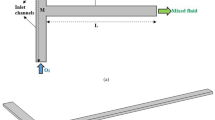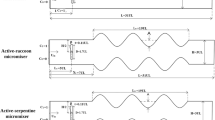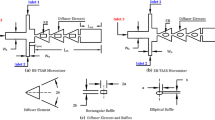Abstract
The performance analysis of wavy micromixers with split and recombine (SAR) elements has been carried out. The two types of SAR elements viz. circular split and recombine elements and elliptical split and recombine elements are used to get benefit of SAR mechanism. The main concept in the proposed design is to enhance the interfacial area between the two fluids by creating a transverse flow and split and recombination of fluid flow streams with the help of SAR elements. The effects of balanced split and unbalanced split of SAR elements and operational parameter Reynolds number on the mixing index and pressure drop are evaluated. The COMSOL Multiphysics 5.0 is used for computational fluid dynamics analysis of micromixers. The analysis is carried out for balanced and unbalanced split of the mixing elements at various Reynolds numbers in the range of 0.1–75. The computation interfacial patterns on the planes perpendicular to the direction of fluid flow, mixing index and pressure drop are studied in depth. The results indicate that at inlet Reynolds number below 5, the mixing performance is diffusion dominated. However at Reynolds number greater than 5, the mixing index increases intensely due secondary flow and separation vortices, as well as SAR effect.













Similar content being viewed by others
References
Alam A, Kim KY (2012) Analysis of mixing in a curved microchannel with rectangular grooves. Chem Eng J 181:708–716
Ansari MA, Kim KY, Anwar K, Kim SM (2010) A novel passive micromixer based on unbalanced splits and collisions of fluid streams. J Micromech Microeng 20(5):055007
Cheri MS, Latifi H, Moghaddam MS, Shahraki H (2013) Simulation and experimental investigation of planar micromixers with short-mixing-length. Chem Eng J 234:247–255
Cortes-Quiroz CA, Azarbadegan A, Zangeneh M (2014) Evaluation of flow characteristics that give higher mixing performance in the 3-D T-mixer versus the typical T-mixer. Sens Actuators B 202:1209–1219
Das SS, Patowari PK (2018) Fabrication of serpentine micro-channels on glass by ultrasonic machining using developed micro-tool by wire-cut electric discharge machining. Int J Adv Manuf Technol 95(5–8):3013–3028
Das SS, Tilekar SD, Wangikar SS, Patowari PK (2017) Numerical and experimental study of passive fluids mixing in micro-channels of different configurations. Microsyst Technol 23(12):5977–5988
Gidde RR, Pawar PM, Ronge BP, Misal ND, Kapurkar RB, Parkhe AK (2017) Evaluation of the mixing performance in a planar passive micromixer with circular and square mixing chambers. Microsyst Technol 24(6):2599–2610
Gidde RR, Shinde AB, Pawar PM, Ronge BP (2018) Design optimization of a rectangular wave micromixer (RWM) using Taguchi based grey relational analysis (GRA). Microsyst Technol 1–16
Hardt S, Drese KS, Hessel V, Schonfeld F (2005) Passive micromixers for applications in the microreactor and μTAS fields. Microfluid Nanofluid 1(2):108–118
Izadpanah E, Hekmat MH, Azimi H, Hoseini H, Rabiee MB (2018) Numerical simulation of mixing process in T-shaped and DT-shaped micromixers. Chem Eng Commun 205(3):363–371
Li J, Xia G, Li Y (2013) Numerical and experimental analyses of planar asymmetric split-and-recombine micromixer with dislocation sub-channels. J Chem Technol Biotechnol 88(9):1757–1765
Lin Y (2015) Numerical characterization of simple three-dimensional chaotic micromixers. Chem Eng J 277:303–311
Liu RH, Stremler MA, Sharp KV, Olsen MG, Santiago JG, Adrian RJ, Aref H, Beebe DJ (2000) Passive mixing in a three-dimensional serpentine microchannel. J Microelectromech Syst 9(2):190–197
Mouza AA, Patsa CM, Schonfeld F (2008) Mixing performance of a chaotic micro-mixer. Chem Eng Res Des 86(10):1128–1134
Nguyen NT, Wu ZG (2004) Micromixers—a review. J Micromech Micro Eng 15(2):R1–R16
Sheu TS, Chen SJ, Chen JJ (2012) Mixing of a split and recombine micromixer with tapered curved microchannels. Chem Eng Sci 71:321–332
Shih TR, Chung CK (2008) A high-efficiency planar micromixer with convection and diffusion mixing over a wide Reynolds number range. Microfluid Nanofluid 5(2):175–183
Stroock AD, Dertinger SK, Ajdari A, Mezic I, Stone HA, Whitesides GM (2002) Chaotic mixer for microchannels. Science 295(5555):647–651
The HL, Ta BQ, Le TH, Dong T, Thoi TN, Karlsen F (2015) Geometric effects on mixing performance in a novel passive micromixer with trapezoidal-zigzag channels. J Micromech Microeng 25(9):094004
Tran-Minh N, Dong T, Karlsen F (2014) An efficient passive planar micromixer with ellipse-like micropillars for continuous mixing of human blood. Comput Method Program Biomed 117(1):20–29
Wangikar SS, Patowari PK, Misra RD (2017) Numerical and experimental investigations on the performance of a serpentine microchannel with semicircular obstacles. Microsyst Technol 24(8):3307–3320
Wong SH, Bryant P, Ward M, Wharton C (2003) Investigation of mixing in a cross shaped micromixer with static mixing elements for reaction kinetics studies. Sens Actuators B 95(1–3):414–424
Xia G, Li J, Tian X, Zhou M (2012) Analysis of flow and mixing characteristics of planar asymmetric split-and-recombine (P-SAR) micromixers with fan-shaped cavities. Ind Eng Chem Res 51(22):7816–7827
Xia GD, Li YF, Wang J, Zhai YL (2016) Numerical and experimental analyses of planar micromixer with gaps and baffles based on field synergy principle. Int Commun Heat Mass Transf 71:188–196
Author information
Authors and Affiliations
Corresponding author
Additional information
Publisher's Note
Springer Nature remains neutral with regard to jurisdictional claims in published maps and institutional affiliations.
Rights and permissions
About this article
Cite this article
Gidde, R.R., Pawar, P.M., Ronge, B.P. et al. Flow field analysis of a passive wavy micromixer with CSAR and ESAR elements. Microsyst Technol 25, 1017–1030 (2019). https://doi.org/10.1007/s00542-018-4071-3
Received:
Accepted:
Published:
Issue Date:
DOI: https://doi.org/10.1007/s00542-018-4071-3




